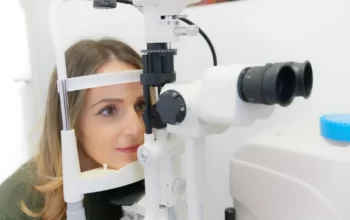
You already understand the purpose of this article if you suffer from strabismus or a lazy eye. If you don’t, you might assume that we are being dramatic or making things up. While this is possible, meeting someone new when you have strabismus can be extremely stressful, and I’m here to help.
People With Lazy Eyes Are Really Looking At You
Lazy eyes can be quite distracting when you first notice them. One of their eyes appears to be looking at you while the other appears to be looking away, which confuses you. That may give the impression that they are not really making eye contact and are not interested in paying attention. Keep in mind that you are the subject of both of their eyes. One of them simply struggles to maintain focus.
Mild adjustments can be made; when I was younger, I occasionally saw a double image because my eyes were focusing differently. However, the majority of people experience them as direct eye contact. Therefore, continue speaking without pausing to check if they are paying attention to you.
7 Tips To Talk To Someone With A Lazy Eye
7 How to meet new people without difficulty if you have strabismus (lazy eye).
- Don’t Overthink it
- Smile
- Don’t layer emotions
- Prepare Ahead of Time
- De-emphasize your eye-turn with a head tilt
- De-emphasize your eye-turn by looking at the right place
Don’t Overthink It
When you have strabismus, how do you make new friends?
Walk up to them, reach out and shake their hand and say, “nice to meet you, I’m ___________.”
I’ve found that most people aren’t even aware of their eye turn or strabismus. In a picture, it would be very clear, but in real life, with all the motion and movement going on, it’s more difficult to see. In fact, I conducted a small experiment last year while I was fixated on my large eye turn in which I purposefully struck up conversations with total strangers, looked them in the eye, and waited.
I’d pay close attention to their eyes to see how they reacted to my blatantly absentmindedness. I had the impression that I was a scientist gathering information.
Did they have a direct gaze? Usually, a bit.
Did they turn around to check behind them? Rarely.
Did they ask me where I was looking? Almost never.
You therefore have nothing to be concerned about 90% of the time. People aren’t that perceptive, but when they are, they usually notice your eye turn and can infer that you are speaking to them. especially if you aren’t taking actions that make the issue worse.
They also don’t care nearly as much as you do. So just act like you’re talking to your mom, sister, dad, or best friend, and carry on as usual.
Smile
Any conversation can be made to feel a certain way.
People join you in that boat when you smile, hold your head high, make eye contact, and exude confidence, which subtly conveys that you don’t care if your eyes aren’t perfect. They may even look up to you and wish they had your assurance.
After I started posting and being open about my lazy eye, a cousin confided in me. She said “I observed how unconcerned you were about your eye. You were so assured and smiled while making eye contact. I came to understand that while we all have flaws, they don’t have to hold us back.”
When you look down, talk in a low voice and frown, you exude insecurity and the idea that “something has gone wrong here.” They’ll join you in that boat, might even avoid you, and if they’re rude, might even say something hurtful to try to break the awkwardness (sometimes unkind people act like that, blah blah blah).
Consider how you would feel if your eyes were flawless, and then decide to feel that way right now.
Don’t Layer Emotions
A person drops their purse in front of you as you are moving down the aisle at the grocery store. You notice, and call out, “excuse me, miss, you dropped your purse.”
She turns around, looks at you, looks behind her, looks back at you and asks, “are you talking to me?” all while you have been looking at her the whole time.
Is anyone else uncomfortable about that? Even though I haven’t experienced this in a while, it still makes me feel the same way I did when I did so many times throughout my life.
But do you want to know how to take something that is justifiably “uncomfortable” and make it 10x worse? Let me demonstrate the emotions and thoughts that lead you there.
“This is uncomfortable” (discomfort)
“I hate my eyes” (loathing)
“I wish that I were different” (sadness)
“Everything is hard with strabismus” (discouragement)
“That lady is so rude” (anger)
“I can’t believe she would make fun of me like that” (judgement)
“I will never be able to make any new friends because of my lazy eye” (hopelessness)
For some reason, we allow our mind to run amok to turn a situation into something that is significantly worse from one that could have been merely mildly uncomfortable.
What is even worse than discomfort, do you want to know?
Discomfort was exacerbated by feelings of loathing, sadness, discouragement, anger, judgment, and hopelessness.
The next time this occurred, what if you distracted your brain?
What if you just thought, “this is a little uncomfortable,” allowed yourself to experience the discomfort and then moved on. The human experience will occasionally be uncomfortable; what if you allowed it rather than allowing it to spiral?

Prepare Ahead Of Time
Prepare your thoughts and words in advance if you are going to teach a class or meet new people so that you can be the person you want to be.
Here are a few situations and some of the ways I chose to handle them, but these may not apply to you or your personality. Plan some solutions that would work for you after giving it some thought.
What do you want to think, say, or do when someone is peering over their shoulder?
They will understand what my eyes are doing in a matter of seconds; I can wait while their brain processes what I am seeing.
It’s fascinating that every human brain reacts to a lazy eye in the same way, by casting a quick glance in the opposite direction.
Helpful Words (said with confidence and love, not snarkiness)
“Oh, I’m looking at you. I know it can be difficult to tell, but this is the working eye (point to straight eye).”
In the past two weeks, I was at Walmart talking to a cashier when I suddenly noticed myself looking over my shoulder. I realized my error as I was turning my head back, and when I looked into her eyes more intently, I saw that she shared my mistake. Her lazy eye was a result of strabismus.
How could I look over my shoulder when speaking to her and commit the unpardonable sin? I have been on her side, and I HATE making her feel how I know she probably feels. I KNOW BETTER.
I made an effort to make up for it by making a lot of eye contact, offering compliments, and engaging in friendly conversation.
However, I made a very significant discovery. Because our brains operate like computers, they attempt to make sense of unusual events before we can react. It’s not rude for people to look behind themselves; it happens naturally.
De-emphasize Your Eye-turn With A Head Tilt
If all the touchy feely, “change your thoughts” ideas aren’t ringing true for you, here are a couple practical solutions to make your lazy eye less noticeable.
If you frequently take selfies, you might already be aware of these facts, but simply tilting your head slightly to the left or right can significantly alter how your eyes appear.
Simply tilt your head in the general direction of where your wandering eye is pointing. Thus, turn your head slightly to the left if it is pointing to the left, and slightly to the right if it is pointing to the right. This makes the eye turn appear less obvious by balancing it between the two eyes.
De-emphasize Your Eye-turn By Looking At The Right Place
Once I switched over to full selfie mode with my website and Instagram, I learned this additional little trick. It is comparable to head tilting and produces the same result, but it feels a little more natural.
When I looked directly at the camera as opposed to just to the left or right, I discovered that my eyes looked completely different. Again, it won’t make it go away, but it will make the person you are meeting less confused, which can help to reduce stress for both of you.
The only difference between these two images is the direction in which I’m looking. I’m simply staring at the top middle of my phone in the photo where my eye turn is obvious. I’m looking at my phone’s top left corner in the image where it is a little less obvious. Some people might not even be able to tell the difference, but in one photo, my eyes appear almost straight, and in the other, it is obvious that I have esotropia.
Simple observation of the opposite eye will reveal exoptropia (eye turned out). Examine the same eye for esotropia (eye turned in).
Most People Know They Have A Lazy Eye
Unfortunately, there are some kids like me who have no idea what their eyes are doing. If you are that person’s parent or a close family member, you should probably let them know about it. However, the majority of people are aware of what their optical system does. If your friend’s situation is making it difficult for you to concentrate, acknowledge it rather than avoiding eye contact. Even if they don’t stare at themselves constantly, they are aware that it is distracting. Say something like this:
“Sometimes your eye starts moving and it throws me off”
Clearly meant for a friend, colleague, or family member, this will make an awkward situation more enjoyable. On a salesperson, flight attendant, or your boyfriend’s mother, avoid using this line. Suffer through it, then move on.
It’s not worth making someone feel self-conscious about their ocular situation when you’re speaking to someone you’ll likely never see again. Find a different area of their face to concentrate on and end the conversation if you are feeling particularly uneasy. Rather than acting uncomfortable if the person is a regular in your life, acknowledge the circumstance.
Is It Feasible To Treat Lazy Eye?
In childhood, the nerves and communication arteries that link the eyes to the brain are developing. Because of this, children aged 7 or younger frequently respond best to treatment for lazy eyes.
The sooner you begin treatment, the more likely it is that you will see positive outcomes. Teenagers, up to about the age of 17, can still see positive effects, though.
If you have lazy eye and are older than 17, don’t let that stop you. It’s important to talk to your doctor about your options because even adults with lazy eyes can frequently improve their vision with treatment.
Treatment options for lazy eye include:
- corrective eyeglasses and contact lenses
- eyepatches
- Bangerter filter
- eye drops
- training
- surgery
Corrective Eyeglasses Or Contact Lenses
Sometimes having different vision in each eye leads to lazy eye. For instance, a person may have myopia or hyperopia in one eye. Each eye’s vision becomes less sharp as a result. Refractive amblyopia is the name given to this.
Another factor contributing to lazy eye is astigmatism, which is an irregular corneal curve in one eye.
Frequently, contact lenses or eyeglasses are able to treat these causes of lazy eye.
Getting A Prescription
You or your child will need to have your eyes examined and evaluated by an eye doctor, such as an ophthalmologist or optometrist, in order to receive this type of eyewear.
For corrective eyewear, you’ll need a prescription, and an optometrist or optician can usually make your glasses.
Cost
Corrective lens costs should be covered if you have health insurance with vision benefits. Nevertheless, you might still be required to pay a deductible or coinsurance sum.
The level of coverage differs between each insurance company. To get the most accurate estimate of your out-of-pocket expenses, make sure to check with your provider.
Your cost for corrective lenses if you don’t have health insurance may vary depending on where you live and the kind of glasses you choose. The price of glasses can range from $35 to several hundred dollars.
Eyepatches
A simple and affordable treatment for lazy eye is wearing an eyepatch. It aids in the weaker eye’s vision improvement.
Every day for between two and six hours, you should cover the eye with better vision with an eyepatch. The length of time the patch should be worn will be determined by your doctor.
It’s critical to adhere to your doctor’s recommendations. Long-term use of the patch may occasionally cause the stronger eye to develop lazy eye. When this occurs, treatment can usually quickly cure the problem.
Where to find
Eyepatch usage is possible both on its own and with corrective lenses. Eye patches might be available from your doctor. If not, they’re easily accessible in pharmacies and online and frequently affordable.
Many eyepatch designs are adorable in order to make them more appealing to young children.
Bangerter Filter
Bangerter filters may provide the same or a similar result for kids who cannot tolerate eyepatch use. These filters are an opaque type of coating that attaches to the inside of the eyeglass lens worn over the dominant eye.
Bangerter filters ought to be worn continuously. As the symptoms get better, they can be altered in terms of density and transparency. They might be helpful as a secondary treatment after patching has taken place for this reason.
Eye Drops
By obstructing the dominant eye’s vision with medication, the weaker eye is forced to work harder. Atropine, also known as Isopto Atropine, is the drug that is typically taken.
Blurred vision results from atropine’s dilated pupil of the eye. In order to force the lazy eye to work harder, it may be used several times per day to reduce vision in the dominant eye.
You’ll Need A Prescription
Atropine must be used in accordance with your doctor’s instructions and is only available with a prescription.
Cost
Insurance will pay for atropine, though your plan might insist that you get the generic version. The cost of this medication can range from $25 to more than $60.
Training
The benefits of games and activities that challenge the weak eye have been demonstrated, but they might not be sufficient to correct vision on their own.
Specific computer or iPad games and tasks, like assembling jigsaw puzzles and creating artwork, are examples of eye training tools.
Training with computer games and videos has been shown to be effective in several small studies, including one from 2016Trusted Source and one from 2018. More research is necessary before it can be said to be efficient enough to be used in place of other forms of therapy, like wearing an eyepatch.
Surgery
To correct a lazy eye, surgery is performed to change the length or placement of the eye muscles. It may be used when amblyopia is caused by a:
- squint
- droopy eyelid
- cataract
Most surgical treatments for lazy eyes need additional methods, like eye patches, to correct vision. The cosmetic appearance of the eye can also be enhanced through surgery.
Success Rates
The success rates for this kind of surgery range widely, from about 30% to 80%.
Risks
The eye may be overcorrected or undercorrected as a result of this type of surgery. Additionally, there are the standard minor risks of any kind of surgery, such as infection.
It is extremely uncommon for complications to cause vision loss.
Recovery
It will take a few days to a week for recovery at home. Tears that are coming out of the eye at this time could be red or pink. Redness in the eye is another possibility. Swelling and mild pain are to be anticipated.
Cost
The price of this type of surgery will vary depending on your insurance and location. They could cost $6,000 or even more.
Conclusion
About 3 out of every 100 kids have lazy eyes, also known as amblyopia. The condition can be treated, and methods like wearing corrective lenses and wearing an eye patch typically work well.
Turning your head, or looking at an eye that de-accentuates your eye turn can make new greetings less uncomfortable, but you are still going to experience some discomfort and that is okay! That is part of being a human. It’s hard for me too.



